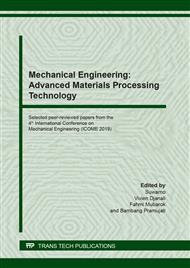[1]
Supriadi, Geographical Information System,. Medan: USU Press (2007) – In Bahasa.
Google Scholar
[2]
Y.C Zhai, W.N. Mu, Y. Liu and Q. Xu, A green process for recovering nickel from nickeliferous laterite ores,, Transactions of the Nonferrous Metals Society of China Vol. 20 (2010) 65–70.
DOI: 10.1016/s1003-6326(10)60014-3
Google Scholar
[3]
J.K. Hamilton, Nickel laterite processing technologies. Perth: ALTA Metallurgical Services (2010).
Google Scholar
[4]
E. Guo, M. Liu, C. Pan, Q. Yuan, and Xuewei Lv, Sintering Process for Limonitic Nickel Laterite,, Proceedings of the Extraction and Processing Division Symposium on Pyrometallurgy (2014) 623-630.
DOI: 10.1002/9781118889657.ch62
Google Scholar
[5]
D. F. González, I. Ruiz-Bustinza, J. Mochón, C. González-Gasca and L. F. Verdeja, Iron Ore Sintering: Process,, Mineral Processing and Extractive Metallurgy Review (2017).
DOI: 10.1080/08827508.2017.1288115
Google Scholar
[6]
R. C. Gupta, Theory and Laboratory Experiments in Ferrous Metallurgy. Delhi: PHI Learning Private Limited (2015).
Google Scholar
[7]
S. Yang, Mi Zhou, W. Tang, T. Jiang, X. Xue, and W. Zhang, Influence of Coke Ratio on the Sintering Behavior of High-Chromium Vanadium-Titanium Magnetite. Basel: MDPI (2017).
DOI: 10.3390/min7070107
Google Scholar
[8]
Z. Cheng, Y. Jian, Z. Lang, L. Yan, G. Zhigang and W. Qiuwang, Experimental study of commercial charcoal as alternative fuel for coke breeze in iron ore sintering process,, Energy Conversion and Management (2016) 1-10.
DOI: 10.1016/j.enconman.2016.06.074
Google Scholar
[9]
IS 9963 (1981): Determination of shatter index of iron ore lumps, sinter and pellets, [MTD 13: Ore and Raw Materials].
Google Scholar
[10]
F. Abdul, S. Pintowantoro, R.B. Yuwandono, Analysis of holding time variations to Ni and Fe content and morphology in nickel laterite limonitic reduction process by using coal-dolomite bed,, AIP Conference Proceedings, (2018), 020033. https://doi.org/10.1063/1.5030255.
DOI: 10.1063/1.5030255
Google Scholar
[11]
F. Abdul, S. Pintowantoro, A. Kawigraha, A. Nursidiq, Effects of reduction temperature to Ni and Fe content and the morphology of agglomerate of reduced laterite limonitic nickel ore by coal-bed method,, AIP Conference Proceedings, (2018), 020034. https://doi.org/10.1063/1.5030256.
DOI: 10.1063/1.5030256
Google Scholar
[12]
F. Abdul, S. Pintowantoro, A.B Hidayatullaah, Analysis of Cylindrical Briquette Dimension on Total Iron Content and the Degree of Metallization in Direct Reduction Process of Iron Ore and Iron Sand Mixture,, Materials Science Forum, (2019), Vol. 964. https://doi.org/10.4028/www.scientific.net/MSF.964.19.
DOI: 10.4028/www.scientific.net/msf.964.19
Google Scholar
[13]
F. K. Crundwell, M. S. Moats, V. Ramachandran, T. G. Robinson, and W. G. Davenport, Extractive Metallurgy of Nickel, Cobalt and Platinum-Group Metals,. Oxford: Elsevier (2011).
DOI: 10.1016/b978-0-08-096809-4.10038-3
Google Scholar
[14]
S. Yang, Mi Zhou, T. Jiang, Y. Wang, and X. Xue, Effect of basicity on sintering behavior of low-titanium vanadium−titanium magnetite,, Transactions of Nonferrous Metals Society of China Vol. 25 (2015) 2087-2094.
DOI: 10.1016/s1003-6326(15)63819-5
Google Scholar
[15]
G.B Stracher, A. Prakash and E.V Sokol, Coal and Peat Fires: A Global Perspective: Volume 1: Coal - Geology and Combustion,. Oxford: Elsevier (2011).
DOI: 10.1016/b978-0-444-52858-2.00024-4
Google Scholar
[16]
T. Umadevi, P. Karthik, P.C. Mahapatra, M. Prabhu, and M. Ranjan, Optimisation of FeO in iron ore sinter at JSW Steel Limited,. Leeds: Maney Publishing (2012).
DOI: 10.1179/1743281211y.0000000080
Google Scholar
[17]
J. Pal, S. Ghorai, A. Ammasia, S.K. Hota, V.M. Koranne, and T. Venugopalan, Improving reducibility of iron ore pellets by optimization of physical parameters,. Belgrade: University of Belgrade (2017).
DOI: 10.2298/jmmb151206014p
Google Scholar
[18]
S. Ikhsan, Study of Gasification of Berau Kalimantan Timur Coal using Fludized Bed Gasification,. Bandung : ITB (2008), - In Bahasa.
Google Scholar


